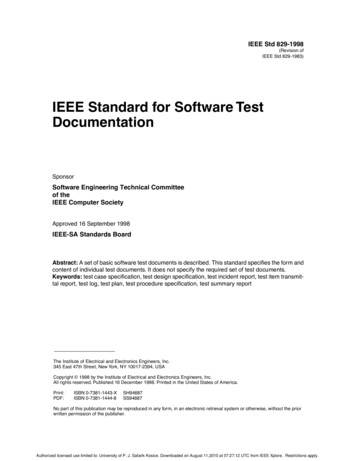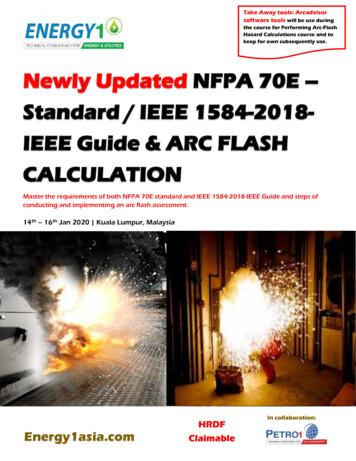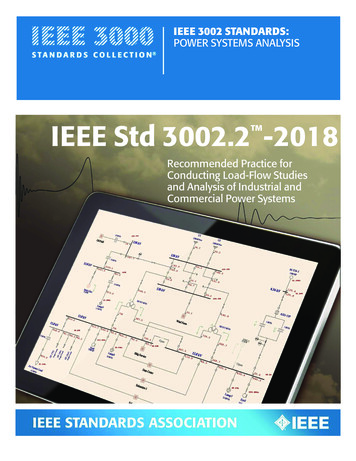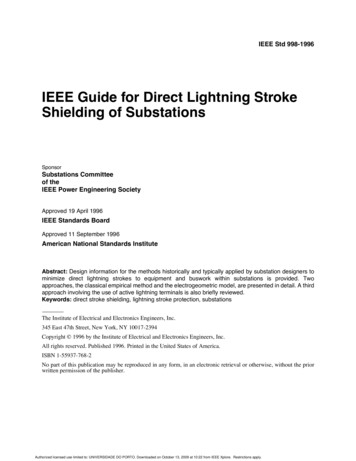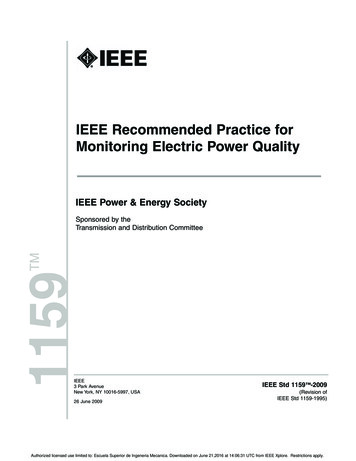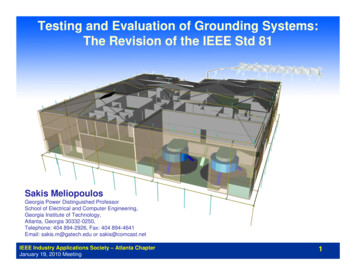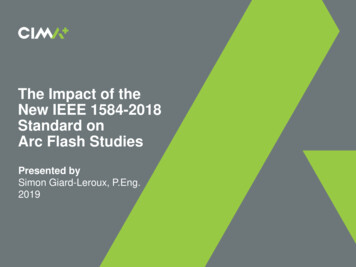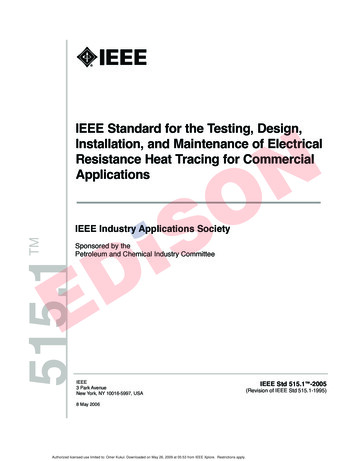
Transcription
IEEE Standard for the Testing, Design,Installation, and Maintenance of ElectricalResistance Heat Tracing for CommercialApplicationsIEEE Industry Applications SocietySponsored by thePetroleum and Chemical Industry CommitteeIEEE3 Park AvenueNew York, NY 10016-5997, USA8 May 2006Authorized licensed use limited to: Omer Kukul. Downloaded on May 26, 2009 at 05:53 from IEEE Xplore. Restrictions apply.IEEE Std 515.1 -2005(Revision of IEEE Std 515.1-1995)
Authorized licensed use limited to: Omer Kukul. Downloaded on May 26, 2009 at 05:53 from IEEE Xplore. Restrictions apply.
Recognized as anAmerican National Standard (ANSI)IEEE Std 515.1 -2005(Revision ofIEEE Std 515.1-1995)IEEE Standard for the Testing, Design,Installation, and Maintenance of ElectricalResistance Heat Tracing for CommercialApplicationsSponsorPetroleum and Chemical Industry Committeeof theIEEE Industry Applications SocietyApproved 16 March 2006American National Standards InstituteApproved 8 December 2005IEEE-SA Standards BoardAuthorized licensed use limited to: Omer Kukul. Downloaded on May 26, 2009 at 05:53 from IEEE Xplore. Restrictions apply.
Abstract: Specific test requirements for qualifying electrical resistance heat tracing forcommercial service. A basis for electrical and thermal design is included. Heating devicecharacteristics are addressed, and installation and maintenance requirements are detailed.Recommendations and requirements for unclassified heating device applications are provided.Keywords: deicing, design, electrical resistance, floor warming, freeze protection, frost heave,heat tracing, heater, heating cable, heating device, installation, maintenance, snow melting,testingTTTTThe Institute of Electrical and Electronics Engineers, Inc.3 Park Avenue, New York, NY 10016-5997, USACopyright 2006 by the Institute of Electrical and Electronics Engineers, Inc.All rights reserved. Published 8 May 2006. Printed in the United States of America.National Electrical Code and NEC are both registered trademarks in the U.S. Patent & Trademark Office, owned by theNational Fire Protection Association, Inc.IEEE is a registered trademark in the U.S. Patent & Trademark Office, owned by the Institute of Electrical and ElectronicsEngineers, Incorporated.Print:PDF:ISBN 0-7381-4905-5ISBN 0-7381-4906-3SH95518SS95518No part of this publication may be reproduced in any form, in an electronic retrieval system or otherwise, without the priorwritten permission of the publisher.Authorized licensed use limited to: Omer Kukul. Downloaded on May 26, 2009 at 05:53 from IEEE Xplore. Restrictions apply.
IEEE Standards documents are developed within the IEEE Societies and the Standards Coordinating Committees ofthe IEEE Standards Association (IEEE-SA) Standards Board. The IEEE develops its standards through a consensusdevelopment process, approved by the American National Standards Institute, which brings together volunteersrepresenting varied viewpoints and interests to achieve the final product. Volunteers are not necessarily members of theInstitute and serve without compensation. While the IEEE administers the process and establishes rules to promotefairness in the consensus development process, the IEEE does not independently evaluate, test, or verify the accuracyof any of the information contained in its standards.Use of an IEEE Standard is wholly voluntary. The IEEE disclaims liability for any personal injury, property or otherdamage, of any nature whatsoever, whether special, indirect, consequential, or compensatory, directly or indirectlyresulting from the publication, use of, or reliance upon this, or any other IEEE Standard document.The IEEE does not warrant or represent the accuracy or content of the material contained herein, and expresslydisclaims any express or implied warranty, including any implied warranty of merchantability or fitness for a specificpurpose, or that the use of the material contained herein is free from patent infringement. IEEE Standards documentsare supplied “AS IS.”The existence of an IEEE Standard does not imply that there are no other ways to produce, test, measure, purchase,market, or provide other goods and services related to the scope of the IEEE Standard. Furthermore, the viewpointexpressed at the time a standard is approved and issued is subject to change brought about through developments in thestate of the art and comments received from users of the standard. Every IEEE Standard is subjected to review at leastevery five years for revision or reaffirmation. When a document is more than five years old and has not beenreaffirmed, it is reasonable to conclude that its contents, although still of some value, do not wholly reflect the presentstate of the art. Users are cautioned to check to determine that they have the latest edition of any IEEE Standard.In publishing and making this document available, the IEEE is not suggesting or rendering professional or otherservices for, or on behalf of, any person or entity. Nor is the IEEE undertaking to perform any duty owed by any otherperson or entity to another. Any person utilizing this, and any other IEEE Standards document, should rely upon theadvice of a competent professional in determining the exercise of reasonable care in any given circumstances.Interpretations: Occasionally questions may arise regarding the meaning of portions of standards as they relate tospecific applications. When the need for interpretations is brought to the attention of IEEE, the Institute will initiateaction to prepare appropriate responses. Since IEEE Standards represent a consensus of concerned interests, it isimportant to ensure that any interpretation has also received the concurrence of a balance of interests. For this reason,IEEE and the members of its societies and Standards Coordinating Committees are not able to provide an instantresponse to interpretation requests except in those cases where the matter has previously received formal consideration.At lectures, symposia, seminars, or educational courses, an individual presenting information on IEEE standards shallmake it clear that his or her views should be considered the personal views of that individual rather than the formalposition, explanation, or interpretation of the IEEE.Comments for revision of IEEE Standards are welcome from any interested party, regardless of membership affiliationwith IEEE. Suggestions for changes in documents should be in the form of a proposed change of text, together withappropriate supporting comments. Comments on standards and requests for interpretations should be addressed to:Secretary, IEEE-SA Standards Board445 Hoes LanePiscataway, NJ 08854USANOTE—Attention is called to the possibility that implementation of this standard may require use of subject mattercovered by patent rights. By publication of this standard, no position is taken with respect to the existence or validity ofany patent rights in connection therewith. The IEEE shall not be responsible for identifying patents for which a licensemay be required by an IEEE standard or for conducting inquiries into the legal validity or scope of those patents thatare brought to its attention.Authorization to photocopy portions of any individual standard for internal or personal use is granted by the Institute ofElectrical and Electronics Engineers, Inc., provided that the appropriate fee is paid to Copyright Clearance Center. Toarrange for payment of licensing fee, please contact Copyright Clearance Center, Customer Service, 222 RosewoodDrive, Danvers, MA 01923 USA; 1 978 750 8400. Permission to photocopy portions of any individual standard foreducational classroom use can also be obtained through the Copyright Clearance Center.Authorized licensed use limited to: Omer Kukul. Downloaded on May 26, 2009 at 05:53 from IEEE Xplore. Restrictions apply.
IntroductionThis introduction is not part of IEEE Std 515.1-2005, IEEE Standard for the Testing, Design, Installation, andMaintenance of Electrical Resistance Heat Tracing for Commercial Applications.The utilization of electrical resistance heat tracing in the commercial construction industry has increasedsteadily due to the availability of more reliable products and more efficient operation. The need exists forbroad-based technical information about electrical resistance heat tracing systems. In the constructionindustry, these systems are used for temperature maintenance of domestic hot water, general freezeprotection of piping and drain lines, roof and gutter deicing, snow melting of concrete and asphaltembankments, frost heave protection of freezer floors in cold storage warehouses, and floor warming as anenhancement for the comfort of office personnel. The approval process for these systems provides the basisfor this standard.This standard provides specific test requirements for qualifying electrical resistance heating devices forcommercial construction and a basis for electrical and thermal design. Type and routine production tests areoutlined in this standard and address such subjects as mechanical durability, resistance to moisture, andelectrical and thermal ratings. This standard outlines specific recommendations dealing with the installationof electrical resistance heat tracing systems for the intended use.Notice to usersErrataErrata, if any, for this and all other standards can be accessed at the following URL: ata/index.html. Users are encouraged to check this URL forerrata periodically.UUInterpretationsCurrent interpretations can be accessed at the following URL: x.html.UUPatentsTTAttention is called to the possibility that implementation of this standard may require use of subject mattercovered by patent rights. By publication of this standard, no position is taken with respect to the existenceor validity of any patent rights in connection therewith. The IEEE shall not be responsible for identifyingpatents or patent applications for which a license may be required to implement an IEEE standard or forconducting inquiries into the legal validity or scope of those patents that are brought to its attention. Apatent holder or patent applicant has filed a statement of assurance that it will grant licenses under theserights without compensation or under reasonable rates and nondiscriminatory, reasonable terms andconditions to applicants desiring to obtain such licenses. The IEEE makes no representation as to thereasonableness of rates, terms, and conditions of the license agreements offered by patent holders or patentapplicants. Further information may be obtained from the IEEE Standards Department.ivCopyright 2006 IEEE. All rights reserved.Authorized licensed use limited to: Omer Kukul. Downloaded on May 26, 2009 at 05:53 from IEEE Xplore. Restrictions apply.
ParticipantsThis standard was developed by members of the 515.1 Working Group, with technical input from a panelof invited experts. The expertise of the panel members within their respective engineering firms includesthe development of specifications and circuit designs for electrical resistance heat tracing for one or all ofthe applications included herein. At the time this standard was completed, the IEEE Industrial ApplicationSociety Working Group had the following membership:Wayne Williams, ChairGeorge B. Tarbutton, Past ChairJohn Turner, SecretaryCharles BonordenDusty BrownRob DeChurchBill HanthornKaty HoldredgePaul HouseAndrew LozinskiSteve PrisbyBob RaffertyDon ReedUmesh SoporyClinton VeitEd WitteThe following invited experts contributed to the technical details of this standard:Don AnkelePeter BaenRoy BarthAndy DonlanDick FarkasNeil FensterRobert HamesFrank HeizerRichard H. HulettBen JohnsonBrian KnoxThe following members of the balloting committee voted on this standard. Balloters may have voted forapproval, disapproval, or abstention.George AlexanderThomas BlairCharles BonordenKeith ChowJames DalyGuru Dutt DhingraKimberly EastwoodAmir El-SheikhC. James EricksonBill HanthornPaul HouseRichard H. HulettBen JohnsonRobert KonnikRoger LawrenceAndrew LozinskiPaul MyersFunso OlorunyomiFrank RocchioLarry RobicheauxJames RuggieriChet SandbergTom ShawJohn TurnerDonald VoltzWayne WilliamsWhen the IEEE-SA Standards Board approved this standard on 8 December 2005, it had the followingmembership:Steve M. Mills, ChairRichard H. Hulett, Vice ChairDon Wright, Past ChairJudith Gorman, SecretaryMark D. BowmanDennis B. BrophyJoseph BruderRichard CoxBob DavisJulian Forster*Joanna N. GueninMark S. HalpinRaymond HapemanWilliam B. HopfLowell G. JohnsonHerman KochJoseph L. Koepfinger*David J. LawDaleep C. MohlaPaul NikolichT. W. OlsenGlenn ParsonsRonald C. PetersenGary S. RobinsonFrank StoneMalcolm V. ThadenRichard L. TownsendJoe D. WatsonHoward L. Wolfman*Member EmeritusvCopyright 2006 IEEE. All rights reserved.Authorized licensed use limited to: Omer Kukul. Downloaded on May 26, 2009 at 05:53 from IEEE Xplore. Restrictions apply.
Also included are the following nonvoting IEEE-SA Standards Board liaisons:Satish K. Aggarwal, NRC RepresentativeRichard DeBlasio, DOE RepresentativeAlan H. Cookson, NIST RepresentativeMichael D. FisherIEEE Standards Project EditorviCopyright 2006 IEEE. All rights reserved.Authorized licensed use limited to: Omer Kukul. Downloaded on May 26, 2009 at 05:53 from IEEE Xplore. Restrictions apply.
Contents1. Overview . 11.1 Scope . 11.2 Purpose . 12. Normative references.
PDF: ISBN 0-7381-4906-3 SS95518 No part of this publication may be reproduced in any form, in an electronic retrieval system or otherwise, without the prior written permission of the publisher. Authorized licensed use limited to: Omer Kukul. Downloaded on May 26, 2009 at 05:53 from IEEE Xplore. Restrictions apply. IEEE Standards documents are developed within the IEEE Societies and the .


